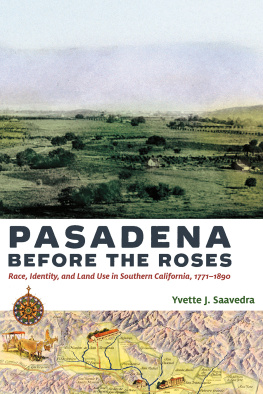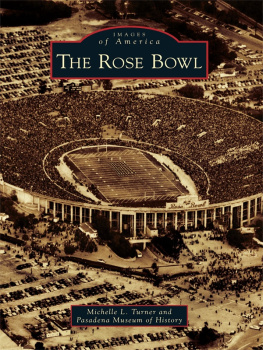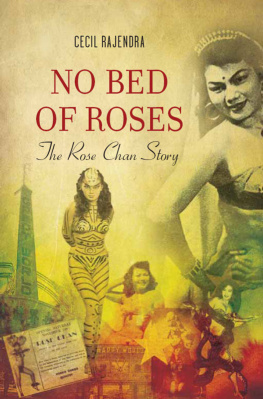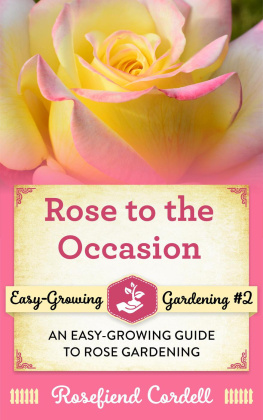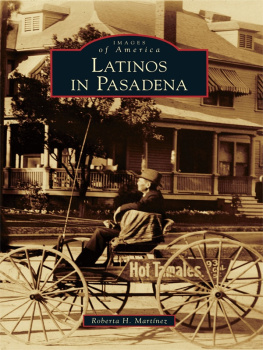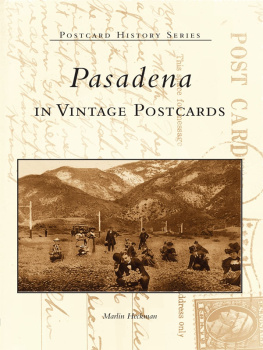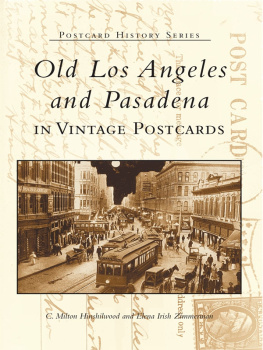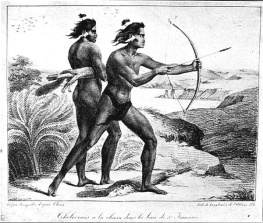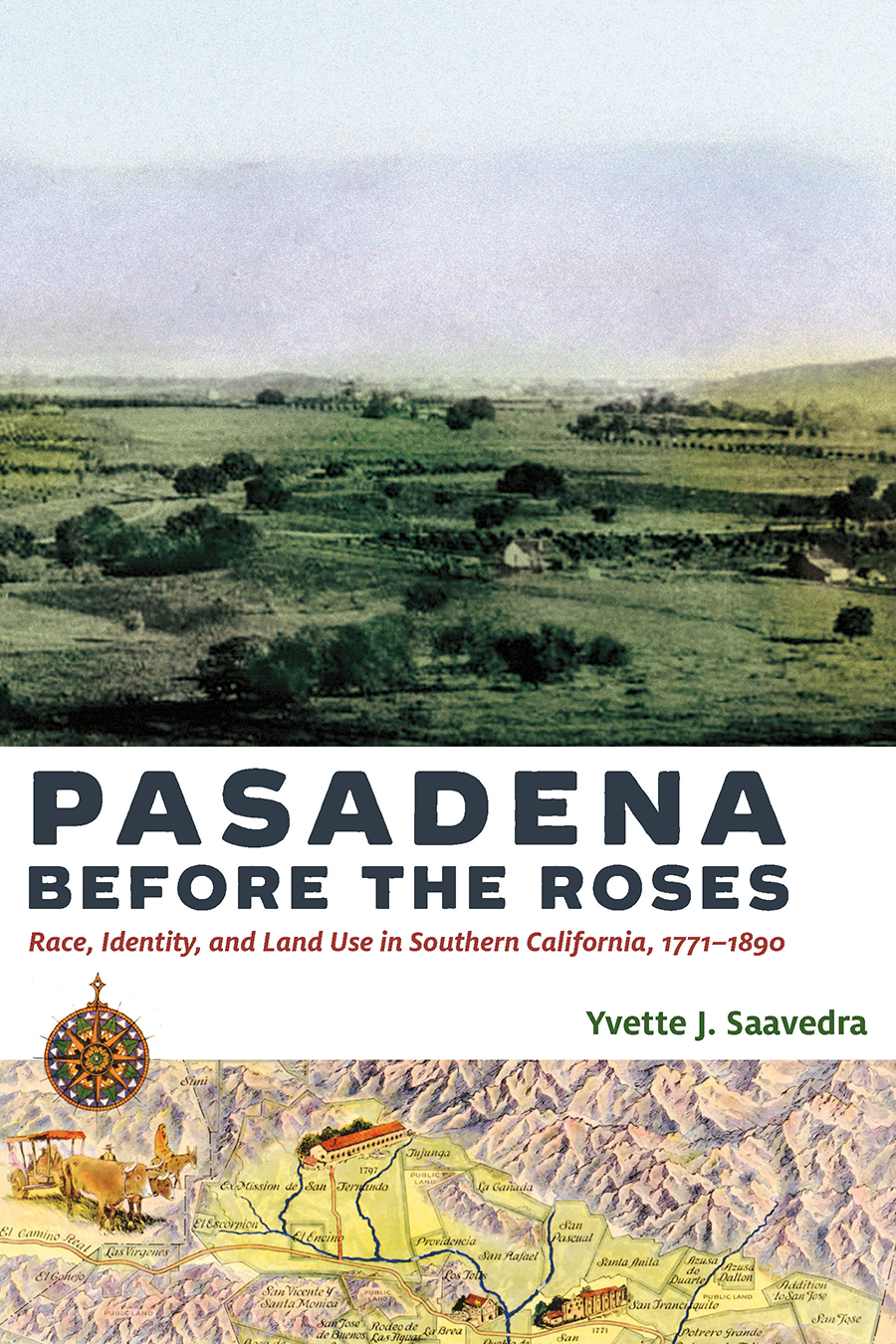
Pasadena Before the Roses
Pasadena Before the Roses
Race, Identity, and Land Use in Southern California, 17711890
Yvette J. Saavedra

The University of Arizona Press
www.uapress.arizona.edu
2018 by The Arizona Board of Regents
All rights reserved. Published 2018
ISBN-13: 978-0-8165-3553-8 (cloth)
Cover design by Carrie House, HOUSEdesign llc
Cover images: [top] Panoramic view of Mission Street and Orange Grove, ca. 1874, USC and California Historical Society; [bottom] Detail from The Old Spanish and Mexican Ranchos of Los Angeles County by Gerald Eddy, Courtesy of the Library of Congress, Geography and Map Division.
Publication of this book is made possible in part by the proceeds of a permanent endowment created with the assistance of a Challenge Grant from the National Endowment for the Humanities, a federal agency.
Library of Congress Cataloging-in-Publication Data
Names: Saavedra, Yvette J., author.
Title: Pasadena before the roses : race, identity, and land use in southern California, 17711890 / Yvette J. Saavedra.
Description: Tucson : The University of Arizona Press, 2018 | Includes bibliographical references and index.
Identifiers: LCCN 2018009205 | ISBN 9780816535538 (cloth : alk. paper)
Subjects: LCSH: Pasadena (Calif.)History19th century. | Pasadena (Calif.)History18th century.
Classification: LCC F869.P3 S23 2018 | DDC 979.4/93dc23 LC record available at https://lccn.loc.gov/2018009205
Printed in the United States of America
This paper meets the requirements of ANSI/NISO Z39.48-1992 (Permanence of Paper).
Contents
Illustrations
Figures
Tables
Acknowledgments
S o many wonderful people have accompanied me on the long and winding journey to completing this book. Both professionally and personally, I have had the backing of mentors, family, and friends who have guided and supported me in countless ways. I could not have completed this book or my PhD without them.
During my graduate study in borderlands history at the University of Texas at El Paso, Cheryl Martin, Jeffrey Shepherd, and Emma Prez helped me develop my understanding of the past in a unique way. Their enthusiastic support of my creative interpretations and analysis, as well as their strength as scholars and professors, has greatly influenced the way I approach my scholarship and the profession. I offer a warm heartfelt thank-you to Deena Gonzlez, professor, esteemed mentor, and trusted friend. Although I didnt know it then, my journey to the PhD began in her undergraduate Chicana/o history class so many years ago. Thank you for your invaluable support, guidance, and friendship throughout the years.
I would like to thank the archivists, librarians, and staff at the various repositories I used in putting this project together. Id especially like to acknowledge those at the Huntington Library, the Bancroft Library, the Honnold-Mudd Library Special Collection in Claremont, the Los Angeles City Archives, Special Collections at the Pasadena City Library, the Santa Barbara Mission Archives, the California State Archives, the USC Libraries, the Seaver Center for Western History Research, and the California State Historical Society. I want to thank everyone from the University of Arizona Press, especially Kristen Buckles. Thank you for your help and support throughout the process; you helped make it a seamless and wonderful experience.
Throughout the years I have been fortunate enough to work with and learn from an amazing community of scholars. I especially thank Antonia Castaeda for her wonderful advice and help at the early stages of this project; her words were invaluable in my conceptualization of this work. I also thank the other scholarsKaren Davalos, Linda Heidenreich, Marne Campbell, Deena Gonzlez, Annemarie Prez, and Isabel Millnwho read this work in its different stages; their feedback along the way helped make it what it is today. To the women of MALCS (Mujeres Activas en Letras y Cambio Social), thank you for showing me the importance and value of the work we do as academics and women of color in the academy. I appreciate your guidance and help with my work but also admire you for your dedication to making a difference on a grander scale.
Thank you to my colleagues in the History Department and the College of Social and Behavioral Sciences at California State University San Bernardino. Your support has been crucial to finishing this project. From research funds and course releases to overall encouragement, you have provided much needed assistance. I truly am lucky to be in such a great department and institution.
Along this road, when I least expected it, I met my partner, Isabel Milln. Thank you for your unconditional love and support in all my endeavorsacademic, professional, and otherwise. I thank you for patiently and critically listening to me talk about this work and encouraging me to just get it done. Thanks for your laughter and love, through the seemingly endless work sessions, the nerd weekends, and the stress; you have been my love, my colleague, and my best friend. I dedicate this book to my parents, Jorge and Leonor. Thank you for instilling in me a love of knowledge. Most of all, thank you for all your hard work; you provided me the opportunity to pursue my dreams, and for this I will be forever grateful. To Crystal, you inspire me in infinite ways; you may not know it, but you kept me going when I wanted to quit. Thanks to my friends Lamin Whittiker, Renee Valenuzuela, and Jose Guerra for your unwavering support. To my many other colleagues and friendsManijeh Badiee, Annika Anderson, Liliana Gallegos, Cherstin Lyon, Marne Campbell, Karen Mary Davalos, and Jeff Shepherdyou all kept me sane through this process. To all of you, and the countless others who have made this book possible, thank you for helping me get here.
Pasadena Before the Roses
Introduction
Before the Roses
Every landscape is thus marked by and offers clues not just to its own history but also, and more profoundly, the layered accumulation of racial formations that are simultaneously local, national, and global.
Laura Barraclough, Making the San Fernando Valley: Rural Landscapes, Urban Development, and White Privilege
T he City of Pasadena is world renowned for its annual Tournament of Roses Parade and Rose Bowl football game. On any given weekend, tourists and locals alike congregate along Colorado Boulevard in Old Town Pasadena to patronize the high-end shops, pubs, and gourmet restaurants. As they traverse the streets of Old Town, the building facades and alleyways transport them to turn-of-the-century Pasadena, a town that emerged out of a colossal land boom resulting from the railroads inauguration into the region. Throughout the city, local establishments display countless photographs of orange groves, majestic landscapes, and harvest festivalscomplete with pictures of men riding horses and ostrichesto tell the story of Pasadenas early American settlers. In 1873 pioneers from Indiana left the cold harsh Midwestern winters behind to establish an agricultural colony in Southern California. From 1873 to 1886 the Indiana Colony grew from a small colony into the city of Pasadena.
Framed in such a way, Pasadenas story is one of Anglo progress. These images and public displays produce a narrative that tether the modern city of Pasadena to its agricultural roots while simultaneously providing a story of transition or progression from uncivilized past to a civilized present. This story represents the Indiana Colony as the beginning of the regions history, displacing the history of the Tongva Indians, Spanish missionaries and colonists, and Californios (Mexican rancheros) that came before the roses.
Next page
